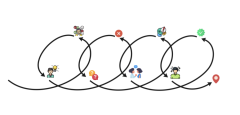
This diary is mainly to sort out the logic behind my project, and to reconfirm the purpose of the project. The original goal of my project is to solve the problematic employment of art students. Especially for those art students who want to support themselves by selling their artworks.
I thought the first reason that the audience won’t buy art paintings is that they don’t have resonance. So my intervention 2 and 3 is to combine other senses to help audiences to understand the meaning behind artworks and have more resonance.
However, for the audience, there is no direct connection between resonating and buying behaviour. I need to find other resonances that can resonate with the purchase behaviour.
I reanalyze the reason behind this question from different aspects (audiences, artists, exhibition, social, education and application), and I am trying to design my next intervention from a different angle.
For example, I can look for a special group as my potential customers, and try to establish the demand for buying art among them. This idea made me think about those people who need art therapy.
Or I can use an exhibition perspective as an entry point. For instance, the popularity of commercial exhibitions created for social media has led to more and more behaviours using exhibitions as background boards for photographing. People don’t want to immerse themselves in and admire a painting, let alone resonate and generate buying behaviour.
But I found that changing from another angle would deviate from my original purpose.
Maybe the problem is that the question I asked is not good enough. ‘How can I strengthen the connection between the audience and the artworks so that the audience will have the desire to buy? ’
Through my interventions 2 and 3, I verified that there is no direct connection between connection and purchase behaviour. Buying behaviour is a very complex behaviour, involving many complex factors, and resonance is only one of them.
In addition, it is too commercial to make buying behaviour the goal of my research. If art is just for buying and selling, this is not what I want.
So, based on the intervention I did before and some thoughts, I decided to optimize my question into: How can I increase the audience’s participation and interaction when visiting the exhibition so that the audience can have more understanding and connection with the artwork?
Of course, this project is not aimed at all art students. First of all, I am aimed at art students who are willing to add other factors to their works, so that the relationship between me and these creators is a cooperative relationship, rather than relying on my own understanding to modify their works. Secondly, as an art student and illustrator myself, I am willing to use my own work to do such experiments.
